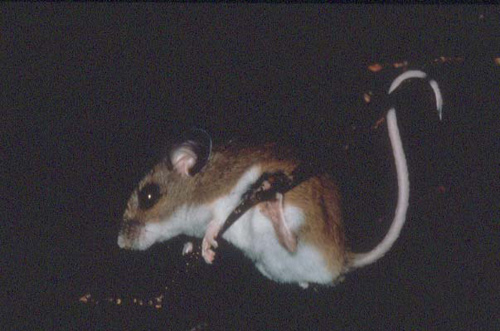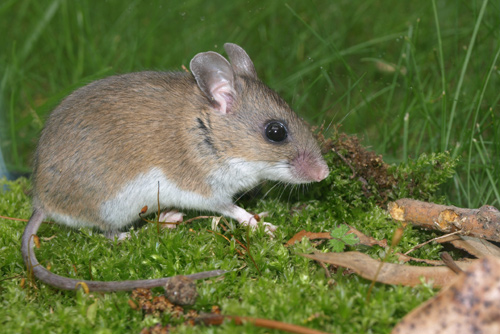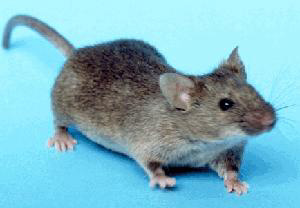The White-footed Mouse is the most common mouse in Connecticut. They have brownish fur above, and white fur underneath. Sometimes a darker strip down the back is visible. They have a 2 1/2 to 4 inch tail and rounded ears that are relatively large. They have a delicate build and weigh 1/2 to 1 1/2 oz.
White-footed mice range through the eastern 3/4 of the US, except for Florida. They are active year-round and nocturnal. These mice live in wooded and overgrown areas but will be in more open areas that are next to wooded areas. They build nests lined with soft materials in nooks such as tree cavities, abandoned burrows of other small animals, woodpiles, rockpiles, buildings and old bird nests.
White-footed mice are omnivores. Typical diet in the wild consists of tree nuts, fruit, berries, seeds, fungus, roots, snails, and insects. They will eat the meat of other tiny creatures if they have the opportunity. They gather extra food in the fall and store a winter food supply using hollows under logs, old bird's nests and other cavities as caches. Mouse droppings look like little dark brown or black pieces of rice
White-footed Mice mate and produce litters most commonly in the spring and the fall.
These little guys climb readily in shrubs and trees and are able to swim. They can get through holes of surprisingly small diameters. In my woodsy area, White-footed and/or Deer mice live mostly outside, but one or two get into our garage now and then. As the colder months approach it is not uncommon for us to find an unfortunate one has wandered into the basement (unfortunate for the mouse because we have 3 cats), probably seeking a warm winter place. Sometimes these mice will try to nest or cache food in the engine compartment of a parked automobile. We have had to put mesh over the air intake of one car usually parked in the driveway because mice see the air filter as a nice home.
If you take the time to look, white-footed mice are amazingly cute. Infrequent, unwanted, lone mouse houseguests can be trapped in little live-traps baited with peanut butter. They must be released some distance away, not just your yard, or they could beat you back inside. Sealing up all the little holes around garages, doors, and basements will help keep them outdoors. White-footed and Deer mice rarely infest homes.
Wild animals can carry some diseases so caution is always warranted. Mice can bite, avoid touching them, their droppings or their remains and wash your hands if you must clean up a mouse-associated mess.
Other Mice in ConnecticutThere are several other kinds of mice found in Connecticut. The Deer Mouse, Peromyscus maniculatus is virtually indistinguishable from the White-footed Mouse. The House Mouse, Mus musculus is a European transplant now found all over the US. These mice do not have white underbelly fur, tend to have a musky unpleasant odor and are the mice most commonly associated with people and houses. They are usually the species responsible for problematic home and farm infestations.
Jumping mice have large hind feet designed for leaping and very long tails. They weigh about 1 oz. They are nocturnal and hibernate over the winter. The Meadow Jumping Mouse, Zapus hudsonius, lives in fields and meadows. They can jump 3 to 4 feet. The Woodland Jumping Mouse, Zapus insignis, inhabits moist forests or areas of heavy shrub cover. They can jump 6 to 8 feet! Jumps like this are impressive for such a tiny little creature.
Neat Facts
White-footed mice eat many damaging gypsy moth caterpillars.
The white mice used in research are usually those bred from the House Mouse,Mus musculus.


